
Aoraia is a genus of moths of the family Hepialidae. There are 13 described species, all endemic to New Zealand. The type species of this genus is Porina dinodes Meyrick, 1890. This genus contains some large species with a wingspan of up to 150 mm.
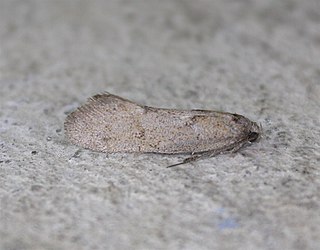
Tingena marcida is a species of moth in the family Oecophoridae. It is endemic to New Zealand and has been observed in Canterbury. Adults are on the wing in September and October.
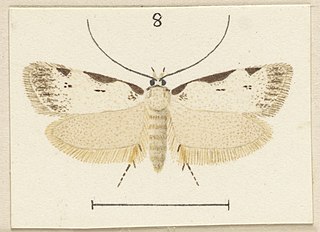
Izatha balanophora is a moth of the family Oecophoridae. It is endemic to New Zealand, where it is widespread in the North Island. Larvae live off the dead bark of kānuka. The adult moths are on the wing during December to March.
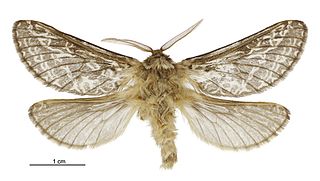
Aoraia aspina is a species of moth of the family Hepialidae. It was described by John S. Dugdale in 1994 from specimens collected in the Tasman, Otago and Southland districts. It is endemic to New Zealand.

Aoraia dinodes is a species of moth of the family Hepialidae. It is endemic to New Zealand. This moth was described by Edward Meyrick in 1890 from specimens collected in Invercargill by Captain Hutton.

Aoraia enysii, also known as the forest ghost moth is a species of moth of the family Hepialidae. It is endemic to New Zealand. This is the only species of the genus Aoraia that can be found in the North as well as the South Island. This species can be found from Mount Te Aroha southwards. This species was described by Arthur Gardiner Butler in 1877 from a specimen obtained in the North Island by J. D. Enys.

Aoraia flavida is a species of moth from the family Hepialidae. It is endemic to New Zealand. This species was described by John S. Dugdale in 1994 from specimens obtained near Gem Lake in the Umbrella Mountains in Southland and collected by B. H. Patrick.
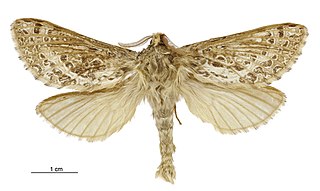
Aoraia insularis, also known as the Rakiura ghost moth, is a species of moth of the family Hepialidae. It is endemic to New Zealand and is found on only on Stewart Island and Steward Island's surrounding smaller islands. It was described by John S. Dugdale in 1994.

Aoraia lenis is a species of moth of the family Hepialidae. It is endemic to New Zealand. It was described by John S. Dugdale in 1994.

Aoraia macropis is a species of moth of the family Hepialidae. It is endemic to New Zealand and is found in the mountains of southern Central Otago. It was described by John S. Dugdale in 1994.

Aoraia oreobolae is a species of moth in the family Hepialidae. This species is endemic to New Zealand. It is classified as "At Risk, Naturally Uncommon" by the Department of Conservation.
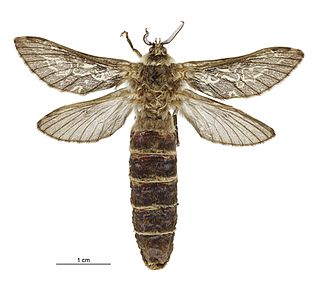
Aoraia orientalis is a species of moth of the family Hepialidae. It is endemic to New Zealand and is found in eastern Central Otago. It was described by John S. Dugdale in 1994.

Aoraia rufivena, also known as the rufous-veined aoraia or the Otago ghost moth, is a species of moth of the family Hepialidae. It is endemic to New Zealand. A. rufivena was described by John S. Dugdale in 1994.

Aoraia senex is a species of moth of the family Hepialidae. It is endemic to New Zealand, where it is known from the South Island. This species was first described by George Vernon Hudson in 1908 from specimens discovered by J. H. Lewis in Central Otago.

Dioxycanus fusca is a species of moth of the family Hepialidae. It is endemic to New Zealand. This species was first described by Alfred Philpott in 1914 as Porina fusca using specimens collected by C. Fenwick and M. O. Pasco. In 1966 L. J. Dumbleton reviewed New Zealand Hepialinae and placed this species within the genus Dioxycanus, giving it the new combination Dioxycanus fuscus.

Wiseana copularis is a species of moth belonging to the family Hepialidae. It is endemic to New Zealand. This moth is one of several very similar looking species within the genus Wiseana and this group are collectively referred to as "Porina" moths. In its larvae form this species consumes pasture grasses and, if numerous, is regarded as a pest by New Zealand farmers reliant on good quality pasture for their stock.

Archyala opulenta is a species of moth of the family Tineidae. This species is endemic to New Zealand and has been found in the upper Maitai Valley in Nelson as well as in Northland. The larvae of this species are associated with endemic bat species as they feed on the guano of Mystacinidae. The adult moths are on the wing in November. It is classified as "Data Deficient" under the New Zealand Threat Classification System by the Department of Conservation.

Pseudocoremia albafasciata, also known as the flash moth, is a species of moth in the family Geometridae. It is endemic to New Zealand. It is classified as Nationally Endangered by the Department of Conservation.

Pseudocoremia lutea is a species of moth in the family Geometridae. It is endemic to New Zealand. It is classified as "At Risk, Naturally Uncommon" by the Department of Conservation.

Aponotoreas dissimilis is a moth of the family Geometridae. It is endemic to New Zealand.



















